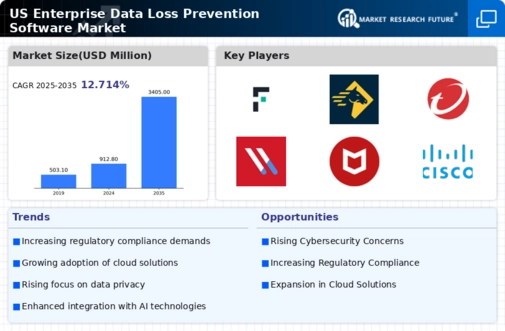The enterprise data loss prevention software market is characterized by a dynamic competitive landscape, driven by the increasing need for organizations to safeguard sensitive information against data breaches and regulatory compliance failures. Key players such as Symantec (US), McAfee (US), and Microsoft (US) are strategically positioned to leverage their technological advancements and extensive customer bases. Symantec (US) focuses on innovation through continuous product enhancements, while McAfee (US) emphasizes partnerships with cloud service providers to integrate DLP solutions seamlessly. Microsoft (US) is enhancing its offerings by embedding DLP capabilities within its broader suite of enterprise solutions, thereby creating a comprehensive security ecosystem. Collectively, these strategies contribute to a competitive environment that is increasingly centered around integrated solutions and customer-centric approaches.
The market structure appears moderately fragmented, with several players vying for market share. Key business tactics include localizing product offerings to meet regional compliance requirements and optimizing supply chains to enhance service delivery. The influence of major players is significant, as they not only set industry standards but also drive innovation through competitive pressures. This competitive structure fosters an environment where agility and responsiveness to market demands are crucial for success.
In November 2025, Forcepoint (US) announced a strategic partnership with a leading cloud provider to enhance its DLP capabilities, integrating advanced machine learning algorithms to improve threat detection. This move is likely to bolster Forcepoint's position in the market by providing customers with more robust and adaptive security solutions, thereby addressing the evolving threat landscape. The partnership underscores the importance of collaboration in enhancing technological capabilities and meeting customer needs.
In October 2025, Digital Guardian (US) launched a new version of its DLP software, incorporating AI-driven analytics to provide real-time insights into data usage and potential risks. This innovation is indicative of a broader trend towards leveraging artificial intelligence to enhance data protection measures. By focusing on real-time analytics, Digital Guardian (US) aims to empower organizations to make informed decisions regarding their data security strategies, thus enhancing their competitive edge.
In September 2025, Proofpoint (US) expanded its DLP offerings by acquiring a cybersecurity startup specializing in behavioral analytics. This acquisition is expected to enhance Proofpoint's capabilities in identifying insider threats and improving overall data protection strategies. The integration of behavioral analytics into DLP solutions reflects a growing recognition of the need for comprehensive security measures that account for both external and internal threats.
As of December 2025, current trends in the enterprise data loss prevention software market are heavily influenced by digitalization, AI integration, and a heightened focus on sustainability. Strategic alliances are increasingly shaping the competitive landscape, as companies recognize the value of collaboration in enhancing their technological capabilities. Looking ahead, competitive differentiation is likely to evolve from traditional price-based competition towards a focus on innovation, technology integration, and supply chain reliability. This shift suggests that organizations will prioritize advanced solutions that not only protect data but also align with broader business objectives.

























Leave a Comment